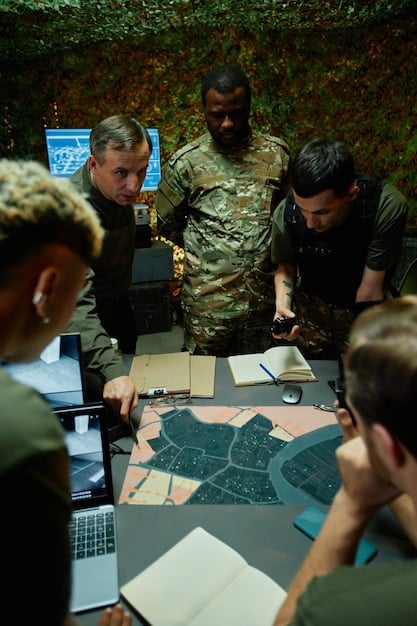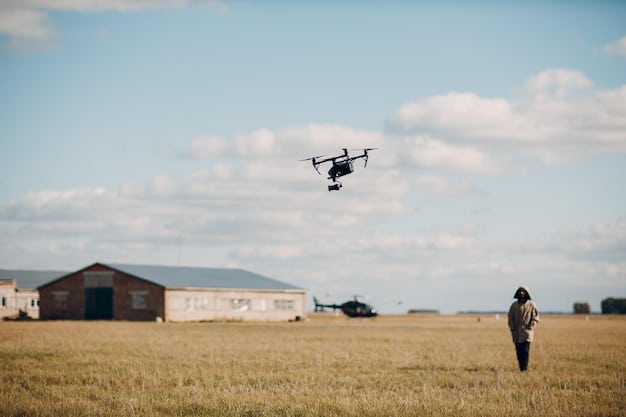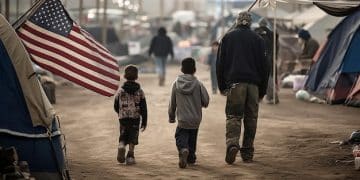US Military’s Evolving Role in Peacekeeping Operations

Advertisements
The US military’s role in international peacekeeping operations has significantly shifted from traditional combat deployments to increasingly nuanced engagements focused on stability, humanitarian aid, and security sector reform, reflecting a complex adaptation to modern global challenges.
Advertisements
The landscape of global security is in constant flux, demanding adaptive and multifaceted responses from major powers. One area witnessing significant transformation is the engagement of the US military’s evolving role in international peacekeeping operations. No longer defined solely by large-scale interventions, this role now encompasses a complex tapestry of stability operations, humanitarian assistance, and security sector reform, challenging traditional military doctrines.
The Shifting Sands of Global Security
The post-Cold War era brought a new paradigm to international relations, marked by the rise of intrastate conflicts, complex humanitarian crises, and transnational threats. This environment necessitated a re-evaluation of how nations, particularly those with significant military capabilities like the United States, contribute to global stability. The traditional concept of peacekeeping, primarily associated with UN blue helmets monitoring ceasefires, began to broaden significantly.
Advertisements
For the US military, this shift has been profound, moving beyond conventional warfare to embrace a more holistic approach to security. This evolution acknowledges that peace is not merely the absence of war but the presence of conditions that facilitate sustainable stability and human development. It requires integrating military force with diplomatic, economic, and social strategies.
From Cold War Confrontation to Complex Contingencies
The end of the Cold War dismantled a bipolar world order, replacing it with a more diffuse, unpredictable threat landscape. This transition forced military planners to contend with conflicts rooted in ethnic, religious, and political grievances, often spilling across borders and creating massive humanitarian disasters. The US military, previously geared for large-scale state-on-state combat, began adapting its doctrine and training to address these multifaceted challenges.
- Rise of intrastate conflicts demanding non-traditional responses.
- Increased focus on humanitarian crises and disaster relief.
- Emergence of transnational threats like terrorism and organized crime.
- Need for interagency and international cooperation in complex environments.
This adaptation wasn’t instantaneous; it involved a learning curve, with early interventions like Somalia and Haiti providing valuable, albeit sometimes painful, lessons on the complexities of stabilization and peacebuilding. These experiences highlighted the importance of understanding local contexts and the limitations of purely military solutions.
Evolving Doctrines and Strategic Frameworks
The US military’s approach to peacekeeping has been informed by lessons learned from decades of engagement. From the early 1990s, policies began to emphasize the importance of legitimacy, burden-sharing, and clear exit strategies. However, the exact role of the military in these operations remains a subject of ongoing debate, balancing the need for decisive action with the imperative to avoid mission creep and excessive entanglement.
Current doctrines increasingly stress the “whole-of-government” approach, where military actions are synchronized with diplomatic efforts, development aid, and governance initiatives. This integrated strategy aims to cultivate conditions for lasting peace, rather than simply suppressing conflict temporarily. It reflects an understanding that military intervention alone rarely achieves sustainable peace.
Key Policy Shifts and Directives
Several key policy documents and presidential directives have shaped the US military’s evolving role. These include shifts from the initial post-Cold War “peace operations” doctrines to more nuanced “stability operations” and “security assistance” frameworks. The emphasis has increasingly been on enabling local partners and building indigenous capacity rather than direct intervention.
- Transition from “peacekeeping” to “stability operations” terminology.
- Increased emphasis on interagency coordination and civil-military cooperation.
- Focus on security sector reform (SSR) and capacity building for partner nations.
- Promotion of rule of law and good governance as foundational elements of peace.
These policy shifts are a response to a recognition that long-term stability is best achieved through empowering local institutions and fostering self-reliance. This approach reduces the burden on US forces while promoting more sustainable outcomes in partner nations.
Training, Capabilities, and Partnerships
To meet the demands of diversified peacekeeping roles, the US military has had to adapt its training, personnel, and equipment. This involves preparing soldiers not just for combat but for roles in advising, mentoring, and facilitating stability. It requires a shift in mindset, emphasizing cultural understanding, communication skills, and an awareness of the socio-political dynamics of conflict zones.
Partnerships are also paramount. The US military often operates alongside UN peacekeepers, regional organizations like the African Union, and host nation forces. These collaborations leverage varied expertise and resources, enhancing the effectiveness and legitimacy of operations. Training exercises frequently involve multinational participants, fostering interoperability and shared understanding.
Specialized Units and Civilian Expertise Integration
The creation of specialized units and the integration of civilian expertise within military operations have been crucial. Civil affairs units, psychological operations teams, and military information support operations (MISO) are examples of specialized capabilities that support stability efforts. Civilian experts in governance, economic development, and humanitarian aid are often embedded with military teams or work in close coordination.
- Development of specialized training programs for stability and reconstruction operations.
- Enhancement of language and cultural proficiency among military personnel.
- Increased reliance on interagency collaboration with USAID, State Department, and other entities.
- Focus on small unit tactics adapted for counter-insurgency and stability missions.
This integration reflects a recognition that modern conflicts cannot be resolved through military means alone. A comprehensive approach that addresses underlying causes of instability, such as poverty, weak governance, and social grievances, is essential for achieving lasting peace.
Challenges and Criticisms

Despite the strategic evolution, the US military’s involvement in peacekeeping operations faces numerous challenges and criticisms. These range from the perennial issue of mission creep and the potential for overextension to the complex ethical dilemmas inherent in armed intervention. The “hearts and minds” approach, while strategically sound, is often difficult to implement effectively in hostile environments.
Another significant challenge is ensuring accountability and preventing unintended consequences. Military operations, even those with humanitarian intent, can sometimes destabilize local power structures or inadvertently fuel grievances. Balancing the need for rapid response with the demands of long-term strategic planning remains a constant struggle.
The Dilemma of Intervention and Sovereignty
The principle of national sovereignty often clashes with the imperative to intervene in humanitarian crises or to prevent wider regional instability. Deciding when and how to intervene, and under what international mandate, is a complex ethical and political tightrope. Critics often point to past interventions that have led to prolonged occupations or failed state-building efforts, highlighting the risks involved.
- Debates over the legal and moral justifications for intervention.
- Risk of mission creep and prolonged military presence.
- Challenges of navigating complex local political landscapes.
- Ensuring accountability for military actions and avoiding unintended harm.
These challenges underscore the need for careful consideration, robust intelligence, and clear objectives before any engagement. The US military’s role is increasingly viewed as one of supporting international efforts rather than leading every intervention unilaterally.
Case Studies and Recent Engagements
Examining specific case studies provides valuable insights into the practical application and challenges of the US military’s peacekeeping and stability operations. From the Balkans in the 1990s to Afghanistan and Iraq in the 2000s, and more recent engagements in Africa, the narrative showcases both successes and significant setbacks. Each operation offers unique lessons about logistics, cultural adaptation, and political complexities.
For instance, while operations in the Balkans demonstrated the efficacy of NATO-led interventions in halting ethnic cleansing, the prolonged engagements in Iraq and Afghanistan highlighted the immense difficulty of nation-building and counter-insurgency in culturally complex environments. These experiences have refined adaptive strategies and emphasized the importance of local ownership of peace processes.
Lessons from Afghanistan and Iraq
The protracted conflicts in Afghanistan and Iraq, though not strictly peacekeeping operations, contained significant elements of stability and counter-insurgency, profoundly shaping US military doctrine. The challenges encountered there – from establishing legitimate governance to building local security forces – have directly informed subsequent approaches to peacekeeping. The importance of understanding local clan dynamics, tribal allegiances, and religious factors became acutely clear.
- The high cost in terms of lives and resources for prolonged interventions.
- Difficulty in translating military superiority into political stability.
- Importance of local buy-in and legitimate governance structures.
- Challenges in training and sustaining indigenous security forces.
These lessons have led to a more cautious and nuanced approach, prioritizing smaller footprint operations, advise-and-assist missions, and greater reliance on diplomatic solutions and economic development as primary tools for long-term stability.
The Future of US Military Engagement in Peacekeeping

Looking ahead, the US military’s role in international peacekeeping operations is likely to continue evolving in response to emerging global threats and technological advancements. The rise of cyber warfare, information operations, and climate change-induced disruptions will demand new skill sets and strategic adaptations. Furthermore, the increasing prominence of great power competition means that peacekeeping efforts must be carefully balanced against broader geopolitical considerations.
There will be an ongoing emphasis on building partner capacity, leveraging technology for intelligence and logistics, and refining interagency coordination. The goal is to move towards even more agile, adaptable, and cost-effective engagements, ensuring that military capabilities are precisely tailored to the specific needs of each situation, fostering long-term stability without entailing endless commitments.
Adapting to New Threats and Technologies
The nature of conflict is changing. Hybrid threats, which combine conventional, irregular, and cyber warfare with disinformation campaigns, pose a significant challenge to traditional peacekeeping models. The US military will need to adapt its training and technology to counter these sophisticated and often amorphous adversaries. This includes investing in artificial intelligence for intelligence gathering, advanced surveillance, and enhanced logistical support critical for operating in remote or denied areas.
- Integration of AI and advanced analytics for conflict prediction and response.
- Focus on cyber security and information warfare in peacekeeping contexts.
- Addressing climate change as a driver of instability and displacement.
- Strengthening partnerships with technological innovations and burden-sharing globally.
The future likely holds a continued shift towards smaller, highly specialized deployments that emphasize training, advisory roles, and strategic logistical support, minimizing direct combat roles unless absolutely necessary. This approach allows for greater flexibility and reduces the risk of entanglement, aligning US interests with global stability effectively.
| Key Point | Brief Description |
|---|---|
| 🌍 Evolving Role | Shift from combat to stability ops, humanitarian aid, and security sector reform. |
| 📚 Doctrine Shifts | Emphasizes “whole-of-government” approach and capacity building for partners. |
| 🛡️ Training & Partnerships | Specialized units and civilian integration for complex, multinational operations. |
| 🔮 Future Outlook | Adapting to cyber threats, climate change, and leveraging AI for agile engagements. |
FAQs: US Military’s Role in Peacekeeping
▼
During the Cold War, the US military primarily focused on large-scale conventional warfare and deterrence against state adversaries. Today, its peacekeeping role has shifted towards addressing intrastate conflicts, humanitarian crises, and transnational threats, emphasizing stability operations, capacity building, and interagency cooperation rather than direct combat.
▼
The “whole-of-government” approach integrates military actions with diplomatic efforts, economic development aid, and governance initiatives. It means the military works closely with the State Department, USAID, and other civilian agencies to achieve comprehensive, sustainable peace outcomes, recognizing that military force alone cannot solve complex conflicts.
▼
Key challenges include mission creep, balancing intervention with national sovereignty, navigating complex local political landscapes, and ensuring accountability for military actions. Furthermore, adapting to hybrid threats and preventing unintended consequences in volatile environments remain significant hurdles.
▼
Training has evolved to include specialized programs for stability and reconstruction, emphasizing cultural understanding, communication, and civil-military cooperation. Personnel are now prepared for advisory and mentoring roles, not just combat, often involving multinational exercises to enhance interoperability with international partners.
▼
Future peacekeeping will increasingly integrate artificial intelligence for intelligence gathering and conflict prediction, advanced surveillance (e.g., drones), and enhanced logistical support. Cybersecurity and information warfare capabilities are also becoming critical to address hybrid threats and protect operations in the digital domain.
Conclusion
The US military’s evolving role in international peacekeeping operations reflects a profound adaptation to a post-Cold War security environment characterized by complex, multi-faceted threats. From traditional combat-centric approaches to nuanced engagements focused on stability, humanitarian assistance, and security sector reform, this evolution underscores a recognition that lasting peace requires more than military might alone. By increasingly emphasizing partnerships, capacity building, and innovative technologies, the US military is striving to forge a more agile, interagency, and internationally collaborative approach to global stability. Despite inherent challenges in intervention and sovereignty, the continuous refinement of doctrine and capabilities prepares the US to address the intricate demands of future peacekeeping efforts, contributing to a safer, more stable world.





